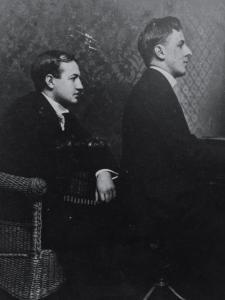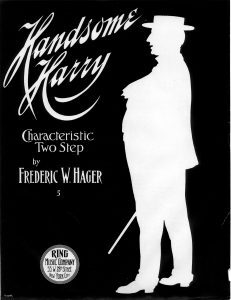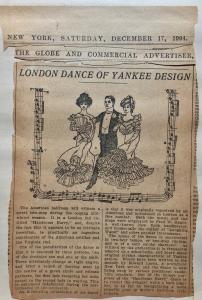
This month’s article in this column will step away from the usual type of research done here; this month we will explore a bit of etymology. To begin—in 1904 recording lab bandleader Fred W. Hager wrote a two step entitled “Handsome Harry.” It was a very catchy and infectious piece that was arranged and published by his long time partner Justin Ringleben.
Looking over the sheet itself, one wouldn’t think much of it, as there doesn’t happen to be anything particularly outstanding about the piece, with a simple pattering melody and generic chord progressions. Naturally, the piece was recorded many times not long after its publication, and was quite popular among New York and later London bands and orchestras. But why write an article on this piece alone? The curiosity lies in the context.
In the latter 19th century, many new slang terms and common colloquialisms arose, a lot of them were lost to time, but some are still in use today. One of these more curious terms is Handsome Harry. The author went on a blind search for this term on a quick whim and was entirely shocked by the amount of information to be read. When you look up this term in period and urban dictionaries, the immediate definition can come as a shock to even the most tolerant. In short, the immediate definition involves a vulgar man getting his way with a girl all dressed up.
As the dig kept getting deeper, there was more to see. This term was associated with generally unsavory men who had their way with many girls and skipping out on them, with this in mind, it was used often in popular culture. There is also a possibility that this term was used as part of the emerging homosexual code of the ragtime era.
In dime novels, songs, newspapers, and later films, the term Handsome Harry recurred. One instance of this term’s use is in a film featuring Mabel Normand in 1913, called A New Hero. Stated in one of the title cards not far into the film, these words are read “Handsome Harry, a devil among the women.” Another example lies in the film series Perils of Pauline, in 1914. While the character of Harry is not identified with this term in any of the title cards, the song “Poor Pauline” (parodying the film series) comments, “Her Handsome Harry is on the scene.”

In the film series, Harry is portrayed as a daring and caring lover of Pauline, but in the end he only wanted one thing from her ——. This is where the popular connotation of the term comes into play, and people watching the film at the time would have understood this, knowing of many fellows they could call Handsome Harry.
So with all this in mind, this begs the question as to why Mr. Hager used this term for his 1904 two step. The cover of the piece consists of a black and white palette, with the title elegantly written in whirly Spencerian, and a white silhouette on a black background. The silhouette could be stated as not quite what most would call handsome—it’s that of a rather large man in a straw hat with a walking stick.
Based on the profile of the face, the cut-out is of the composer himself. Indeed, it is a very creative way to include the likeness of the composer with no picture in sight.
Hager obviously thought himself quite handsome, even with that girthy shape of his, so in that sense of the term it lends itself merit. But what about the vulgar connotations of the term? There’s no way to definitively connect this context with Hager, but hints of his intentions are present.

In the middle 1870s, several Comstock Laws came into effect, prohibiting all obscene materials speaking overtly of sexuality and so on. By the 1890s, many composers and writers started to get around these rules by adopting copious amounts of slang and double meaning terms in their works.
With this in mind, it’s possible that Hager intended to do this with a few of his other compositions at this time, one being his 1902 piece with Justin Ringleben “I’ve Got My Eyes on You,” which on the surface seems like any romantic waltz of the era, but seems oddly meaningful in being the song that christened their relationship of half a century.
He had monumental success in 1903 with his most popular composition “Laughing Water,” and such success he had from this piece may have left him feeling a bit cocky, thinking it clever to give a name like “Handsome Harry” to a simple melody he and Ringleben had written. According to Hager’s writing, he was very worldly with his language, and enjoyed poking at the readers of his lyrics. He often used double meaning words and terms in his lyrics, and often wrote with himself in mind. Even in his old age he was writing stories about an ambitious young bandmaster who enjoyed wearing flamboyant costumes and dreamt of becoming a poet; such a character type is suspiciously similar to his own personality as a young man.
Again it is nearly impossible to know what exactly Hager’s intentions were for naming his piece in this way, but the implications of such salacious meaning can get many of us wondering. How many other songs and two steps of this era could potentially have stories like this? Many alliterative titled pieces were written at this time, but with Hager’s, there’s something different about it.
Many scholars of language and vernacular have done studies on general terms like Handsome Harry, but the underlying vernacular of song lyrics and titles of this era remains largely unexplored. It was entirely unexpected by the author that Hager’s lyrics and personal writings could open up such an unusual and, rather tantalizing, topic. This could spark curiosity for more reading between the lines of popular songs of this era.
Also see:
Perry Bradford, Fred Hager, and Mamie Smith’s Crazy Blues
Fred Hager’s Scraps and Scribbles
Fred Hager and the Birth of Country Music
Fred Hager tangles with Victor Herbert
James: The Other Hager Brother
R. S. Baker has appeared at several Ragtime festivals as a pianist and lecturer. Her particular interest lies in the brown wax cylinder era of the recording industry, and in the study of the earliest studio pianists, such as Fred Hylands, Frank P. Banta, and Frederick W. Hager.






















